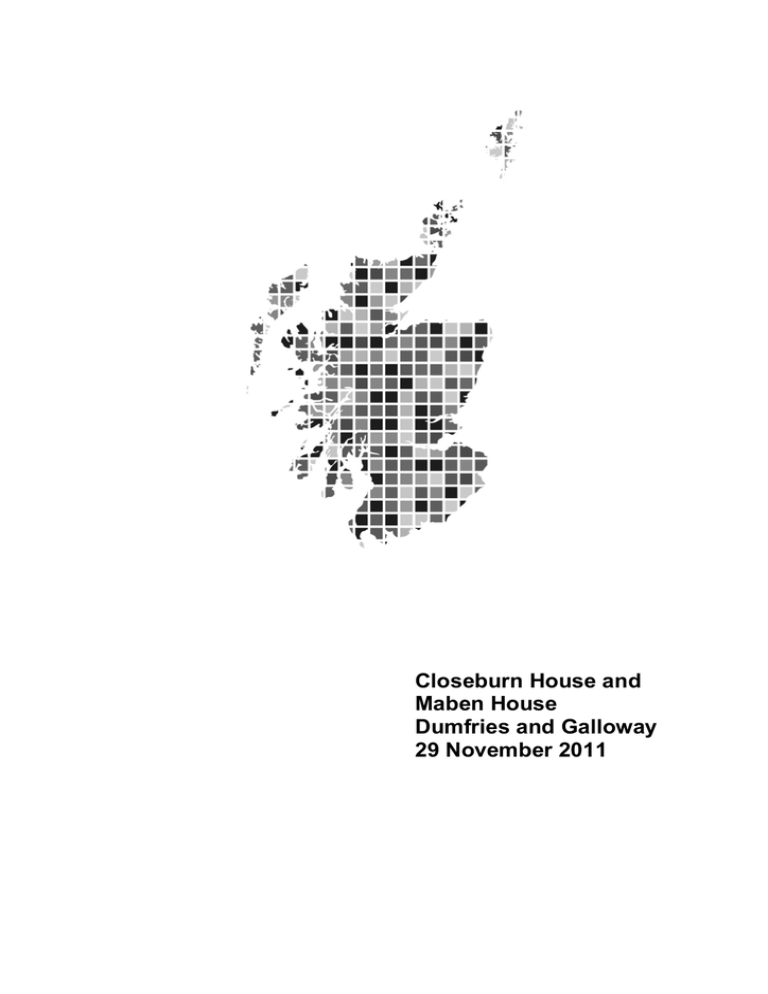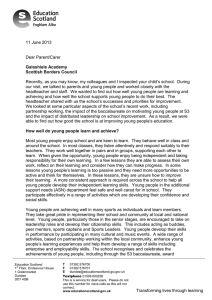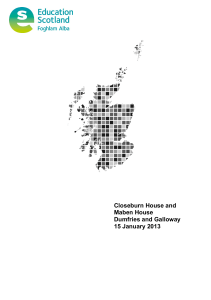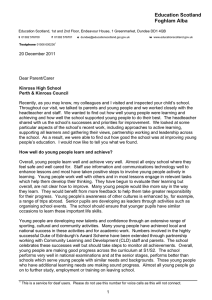Closeburn House and Maben House Dumfries and Galloway
advertisement

Closeburn House and Maben House Dumfries and Galloway 29 November 2011 Education Scotland inspect schools in order to let parents1 and young people know whether their school2 provides a good education. Inspectors also discuss with staff how they can improve the quality of care and education. At the beginning of the inspection, we ask the headteacher/senior managers and staff about the strengths of the school, what needs to improve, and how they know. We use the information they give us to help us plan what we are going to look at. During the inspection, we go into classes and join other activities in which young people are involved. We also gather the views of young people, parents, staff and members of the local community. We find their views very helpful and use them together with the other information we have collected to arrive at our view of the quality of care and education. This report tells you what we found during the inspection and the quality of care and education in the service. We describe how well young people are doing, how good the service is at helping them to learn and how well it cares for them. We comment on how well staff, parents and young people work together and how they go about improving the service. We also comment on how well the service works with other groups in the community, including services which support young people. Finally, we focus on how well the service is led and how staff help the service achieve its aims. If you would like to learn more about our inspection of the service, please visit www.educationscotland.gov.uk. Here you can find analyses of questionnaire returns from young people, parents and staff, and details about young people’s examination performance. We will not provide questionnaire analyses where the numbers of returns are so small that they could identify individuals. 1 Throughout this report, the term ‘parents’ should be taken to include foster carers, residential care staff and carers who are relatives or friends. 2 The term ‘school’ includes the nursery class or classes where appropriate. Contents 1. The service 2. Particular strengths of the service 3. How well do children and young people learn and achieve? 4. How well do staff work with others to support children and young people’s learning? 5. Are staff and children and young people actively involved in improving their service community? 6. Does the service have high expectations of all children and young people? 7. Does the service have a clear sense of direction? 8. What happens next? 1. The service Closeburn House and Maben House form an independent residential service situated on two sites. The service provides education and care for young people aged nine to 16 years with additional support needs including significant social, emotional and behavioural needs from local authorities across the UK. The roll was ten when the inspection was carried out in October 2011. Nine young people were receiving residential care and one was attending daily. 1 2. Particular strengths of the service • The friendly ethos and positive relationships amongst staff and young people. • Partnerships with parents, other agencies and the local community that extend young people’s learning experiences. • Preparing young people for moving on from the service. 3. How well do children and young people learn and achieve? Learning and achievement Teachers have established positive relationships with young people and this helps them to feel safe and included. Overall, young people participate well in lessons and respond best when they are actively involved in learning. However, much of their work involves textbook activities that they complete on their own. Young people need more opportunities to learn through working with others to find solutions and to work things out for themselves. They are gaining confidence in learning and in their ability to achieve. They are not yet sufficiently involved in evaluating their own progress and thinking about what they need to do to improve. Young people achieve success in the classrooms and beyond. They are improving their personal and social skills and developing positive attitudes towards others. Most young people have a good awareness of healthy lifestyles and take part in a range of physical activities in school and in the local community. They are developing their citizenship skills through charitable fundraising. A few young people take part in work experience programmes that help them develop skills 2 for life and work. Almost all young people have their achievements recognised through the Award Scheme Development and Accreditation Network (ASDAN). Overall, young people are making steady progress in English language and mathematics. Most young people achieve National Qualification units and courses in a range of subjects at Access 2, 3 and Intermediate 1 levels. Staff now need to develop better approaches to tracking young people’s progress to ensure that they are achieving at an appropriate rate and at a sufficiently high level. Curriculum and meeting learning needs The curriculum provides young people with learning experiences in the eight areas of Curriculum for Excellence. It gives them suitable opportunities to gain National Qualifications. The service is still at the early stages of implementing Curriculum for Excellence and there is considerable scope to develop more enjoyable and relevant programmes of study. Young people have a range of opportunities for physical activities and various organisations provide activities to help young people know how to keep themselves safe and healthy. However, there is no well-planned programme for health and wellbeing. The service gives good attention to preparing and supporting young people move on from the service. Most staff know young people well and interact with them in a caring and supportive manner. In a few classes, staff set tasks and activities at the right level of difficulty for young people. However, the majority of activities are not interesting enough and do not motivate young people to learn. Staff work with partners to identify young people’s needs when they come to the service. Young people’s specific needs are not always addressed well. They need to be given more opportunities to learn how to recognise their own feelings and to behave well in different situations. Young people have regular opportunities to discuss aspects of their progress with their key worker and key teacher. However, learning targets within their individual 3 educational programmes are not always sufficiently challenging or clearly linked to their specific needs. The service regularly reviews young people’s progress involving parents, partners and pupils. 4. How well do staff work with others to support children and young people’s learning? The service has developed strong partnerships with parents who value the support of the staff. Parents feel welcome and are able to contact staff if they have any issues or concerns. The service has effective arrangements to gather the views of parents and deal with complaints. The service has positive links with local sports, health and leisure facilities that extend young people’s learning activities. Staff liaise well with services in young people’s home areas so that they can continue to use similar facilities when they leave the service. A full range of agencies and authorities attend planning meetings for young people. 5. Are staff and children and young people actively involved in improving their service community? Young people are involved in improving the service through the pupil council and contributing ideas in working towards Eco-Schools Scotland awards. However, they are not involved in giving their views on how to improve learning. Teaching staff have started to observe each other’s practice. They need to be more fully involved in evaluating the work of the service and setting future priorities for improvements. Most staff do not have a shared understanding of what the service does well and where it needs to improve. Some priorities in the improvement plan are leading to more positive outcomes for young people. For example, young people now have access to a wider range of National Qualifications and they are benefitting from a more practical approach to science. Staff now need to ensure that all new developments are making a difference to young people’s learning and achievements. 4 6. Does the service have high expectations of all children and young people? Staff know young people well and are committed to providing a caring and supportive learning environment. They understand their responsibilities for protecting young people and ensuring their safety. Young people’s achievements are recognised and celebrated through assemblies, achievement certificates and in wall displays. Young people take part in activities that help them to learn about different races and cultures. Staff have high expectations for young people’s attendance. They do not always have suitably high expectations for what young people can achieve across different aspects of their learning and behaviour. Young people are supported to make healthy eating choices. The service’s approach to promoting health and wellbeing needs to be further developed in consultation with the children and young people. 7. Does the service have a clear sense of direction? Staff share a sense of responsibility to provide young people with successful learning experiences. They now need to focus more on improving learning, teaching and the curriculum. Most teachers are relatively new to the service. Team working within the education staff should continue to be developed. Staff need to build a shared understanding of high quality learning and teaching that will meet the needs of all learners. The Head of Education should maintain a strong role in driving forward positive changes. She needs to challenge and support staff to improve outcomes for young people. 8. What happens next? We will carry out a follow-through inspection visit within one year of publication of this report and will report to parents on the extent to which the service has improved. Following that visit, we may continue to check the improvements the service has made. We may also carry 5 out a second follow-through inspection within two years of the original inspection report. If a second follow-through inspection visit is necessary then it will result in another report to parents on the extent of improvement that the service has made. We have agreed the following areas for improvement with the service. • Continue to develop the curriculum and a shared understanding of high quality learning and teaching. • Take better account of the specific needs of young people to support their achievements and health and wellbeing. • Develop more rigorous approaches to self-evaluation to bring about continuous improvement. 6 Quality indicators help schools and inspectors to judge what is good and what needs to be improved in the work of the service. You can find these quality indicators in the HMIE publication How good is our school Here are the evaluations for Closeburn House and Maben House. Improvements in performance Learners’ experiences Meeting learning needs satisfactory satisfactory weak We also evaluated the following aspects of the work of the service. The curriculum Improvement through self-evaluation Managing Inspector: Olwynne Clark 29 November 2011 7 satisfactory weak When we write reports, we use the following word scale so that our readers can see clearly what our judgments mean. excellent very good good means means means satisfactory weak unsatisfactory means means means outstanding, sector leading major strengths important strengths with some areas for improvement strengths just outweigh weaknesses important weaknesses major weaknesses If you would like to find out more about our inspections or get an electronic copy of this report, please go to www.educationscotland.gov.uk. Please contact us if you want to know how to get the report in a different format, for example, in a translation, or if you wish to comment about any aspect of our inspections. You can contact us at Enquiries@educationscotland.gsi.gov.uk or write to us at BMCT, Education Scotland, Denholm House, Almondvale Business Park, Almondvale Way, Livingston EH54 6GA. Text phone users can contact us on 01506 600 236. This is a service for deaf users. Please do not use this number for voice calls as the line will not connect you to a member of staff. You can find our complaints procedure on our website www.educationscotland.gov.uk or alternatively you can contact our Complaints Manager, at the address above or by telephoning 01506 600259. Crown Copyright 2011 Education Scotland


